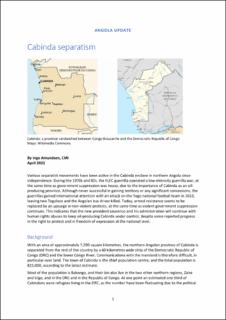Cabinda separatism
Others
Permanent lenke
https://hdl.handle.net/11250/2737179Utgivelsesdato
2021-04-01Metadata
Vis full innførselSamlinger
- Publications [1488]
Originalversjon
Bergen: Chr. Michelsen Institute (Update)Sammendrag
Various separatist movements have been active in the Cabinda enclave in northern Angola since independence. During the 1970s and 80s, the FLEC guerrilla operated a low-intensity guerrilla war, at the same time as government suppression was heavy, due to the importance of Cabinda as an oil-producing province. Although never successful in gaining territory or any significant concessions, the guerrillas gained international attention with an attack on the Togo national football team in 2010, leaving two Togolese and the Angolan bus driver killed. Today, armed resistance seems to be replaced by an upsurge in non-violent protests, at the same time as violent government suppression continues. This indicates that the new president Lourenco and his administration will continue with human rights abuses to keep oil-producing Cabinda under control, despite some reported progress in the right to protest and in freedom of expression at the national level. Background With an area of approximately 7,290 square kilometres, the northern Angolan province of Cabinda is separated from the rest of the country by a 60 kilometres wide strip of the Democratic Republic of Congo (DRC) and the lower Congo River. Communications with the mainland is therefore difficult, in particular over land. The town of Cabinda is the chief population centre, and the total population is 825,000, according to the latest estimate. Most of the population is Bakongo, and their kin also live in the two other northern regions, Zaire and Uíge, and in the DRC and in the Republic of Congo. At one point an estimated one third of Cabindans were refugees living in the DRC , as the number have been fluctuating due to the political situation in Angola, the seesawing civil war and oppression in the DRC, and by opportunities in the artisanal (informal) diamond mines in northern Angola. Consisting largely of tropical forest, Cabinda produces hardwoods, coffee, cocoa, cru
